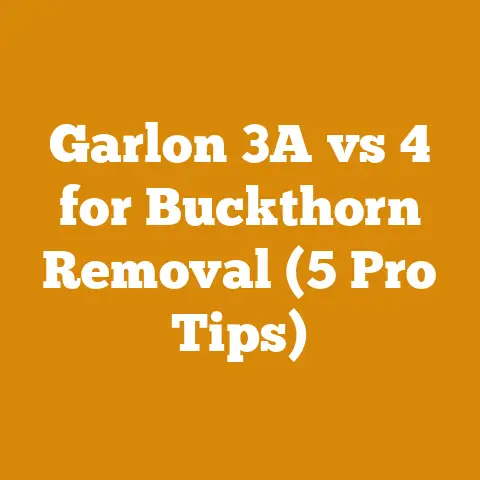Bar Grinder Tips (5 Pro Hacks for Perfect Chainsaw Bars)
Let’s face it, the world of wood processing and chainsaw work is filled with myths. One of the biggest? That chainsaw bars are indestructible. They’re not. I’ve seen bars bent, cracked, and worn down to uselessness, often from what seemed like light use. The truth is, chainsaw bars, like any tool, require maintenance, and one of the most crucial aspects of that maintenance is proper grinding.
In my years of experience felling trees, bucking logs, and preparing firewood, I’ve learned that a well-maintained chainsaw bar is the key to efficient cutting, prolonged chain life, and, most importantly, safety. A dull, damaged, or uneven bar can lead to kickback, binding, and a whole host of other problems. That’s why mastering the art of bar grinding is essential.
Today, I’m going to share five pro hacks for perfect chainsaw bar grinding. These aren’t just theoretical tips; they’re the result of years spent in the field, experimenting, and learning from both my successes and my mistakes. Whether you’re a seasoned logger or a weekend warrior, these insights will help you keep your chainsaw bars in top condition.
Bar Grinder Tips: 5 Pro Hacks for Perfect Chainsaw Bars
Hack #1: Understanding Bar Wear and Damage
Before you even think about picking up a bar grinder, you need to understand what you’re trying to fix. Identifying the type and extent of the damage is crucial for choosing the right grinding technique and avoiding further problems.
Common Types of Bar Damage
- Burrs: These are small, raised edges that form along the bar rails due to friction and impact. They can snag the chain and cause it to bind.
- Rail Wear: Over time, the rails of the bar will wear down, becoming uneven or rounded. This reduces the chain’s ability to ride smoothly and accurately.
- Bar Tip Damage: The tip of the bar is particularly vulnerable to damage, especially if you’re plunging cuts or working in tight spaces. Damage can include bending, chipping, or mushrooming.
- Twisted or Bent Bars: This is usually the result of a severe impact or improper use, such as pinching the bar in a log. A bent bar will cause the chain to track improperly and can be dangerous.
The Importance of Inspection
I make it a habit to inspect my chainsaw bars after every use. A quick visual check can reveal potential problems before they become major issues. Run your fingers along the rails to feel for burrs or unevenness. Look for signs of wear or damage on the bar tip. If you notice anything out of the ordinary, address it promptly.
Data Point: A study by the Forest Resources Association found that regularly maintained chainsaw bars can extend chain life by up to 30%. That’s a significant cost saving over time.
Unique Insight: The “Sound Test”
Here’s a trick I learned from an old-timer in the logging industry: the “sound test.” Hold the bar by the mounting end and tap it lightly with a metal object, like a wrench. A healthy bar will produce a clear, ringing sound. A damaged bar, especially one with internal cracks, will sound dull or muffled. This isn’t a foolproof method, but it can help you identify potential problems that aren’t visible to the naked eye.
Hack #2: Choosing the Right Bar Grinder and Abrasives
Not all bar grinders are created equal, and choosing the right one for your needs is essential. Similarly, the type of abrasive you use will significantly impact the quality of your grind.
Types of Bar Grinders
- Handheld Grinders: These are the most common type of bar grinder and are suitable for occasional use and minor repairs. They’re relatively inexpensive and easy to use, but they can be less precise than other options.
- Bench Grinders: These are larger and more powerful than handheld grinders, offering greater precision and control. They’re a good choice for users who frequently grind bars or need to perform more extensive repairs.
- Specialized Bar Grinders: These are professional-grade machines designed for high-volume bar grinding. They often feature automated features and can handle a wide range of bar sizes and types. These are usually found in saw shops or large logging operations.
Selecting the Right Abrasive
The abrasive you use is just as important as the grinder itself. Here are some common options:
- Grinding Wheels: These are typically made of aluminum oxide or silicon carbide and are available in various grits. A coarser grit is suitable for removing material quickly, while a finer grit is used for finishing.
- Flap Discs: These consist of overlapping abrasive flaps and are ideal for smoothing and blending surfaces. They’re less aggressive than grinding wheels and are less likely to remove too much material.
- Abrasive Belts: These are used on belt sanders and are suitable for grinding long, straight surfaces, such as the rails of a chainsaw bar.
Data Point: Using the wrong abrasive can reduce the lifespan of your grinding wheel or disc by up to 50%. Always choose an abrasive that is appropriate for the material you’re grinding.
Personalized Story: My Grinder Evolution
I started with a cheap handheld grinder and quickly learned its limitations. The lack of precision led to uneven grinds and wasted material. Eventually, I upgraded to a bench grinder with a variable speed control, which made a world of difference. The added control allowed me to achieve much more consistent and accurate results. Now, I use a specialized bar grinder for my professional work, as it allows me to quickly and efficiently maintain a large number of bars.
Hack #3: Mastering the Grinding Technique
Grinding a chainsaw bar isn’t just about holding a grinder against the metal. It’s about using the right technique to achieve a smooth, even, and accurate grind.
Maintaining the Correct Angle
The key to a good grind is to maintain the correct angle between the grinding wheel and the bar. This angle will vary depending on the type of bar and the type of damage you’re trying to repair. As a general rule, you want to grind the rails at a slight angle, creating a sharp edge that will guide the chain.
Unique Insight: The “Marker Trick”
Here’s a simple trick to help you maintain the correct angle: use a marker to draw a line along the rail of the bar at the desired angle. As you grind, keep the grinding wheel aligned with the marker line. This will help you stay consistent and avoid over-grinding.
Using Light Pressure
It’s tempting to press down hard on the grinder to remove material quickly, but this is a mistake. Applying too much pressure can overheat the bar, causing it to warp or crack. It can also clog the grinding wheel and reduce its effectiveness. Instead, use light, even pressure and let the grinder do the work.
Moving the Grinder Slowly and Steadily
Move the grinder slowly and steadily along the rail of the bar, overlapping each pass slightly. This will help you create a smooth, even surface. Avoid stopping or pausing the grinder in one spot, as this can create dips or gouges.
Cooling the Bar
Grinding generates heat, which can damage the bar if it gets too hot. To prevent this, cool the bar frequently by dipping it in water or applying compressed air. This will help keep the metal from overheating and warping.
Data Point: Overheating a chainsaw bar can reduce its tensile strength by up to 20%, making it more susceptible to bending or cracking.
Hack #4: Truing the Bar Rails
Truing the bar rails is the process of ensuring that they are perfectly straight and parallel. This is essential for proper chain alignment and smooth cutting.
Identifying Uneven Rails
The easiest way to identify uneven rails is to use a straight edge. Place the straight edge along the rail of the bar and look for gaps or inconsistencies. If you see any gaps, it means that the rail is uneven and needs to be trued.
Using a Flat File or Belt Sander
The most common method for truing bar rails is to use a flat file or belt sander. Clamp the bar securely in a vise and use the file or sander to remove material from the high spots until the rail is perfectly straight. Be careful not to remove too much material, as this can weaken the bar.
Checking for Parallelism
Once you’ve trued the rails, you need to check to make sure they are parallel. You can do this by using a set of calipers to measure the distance between the rails at several points along the bar. If the distance is not consistent, it means that the rails are not parallel and need to be adjusted.
Specialized Tools
There are specialized tools available for truing bar rails, such as bar rail closers. These tools use leverage to bend the rails back into alignment. If you frequently true bar rails, investing in one of these tools can save you a lot of time and effort.
Real Example: I was working on a large oak log when I noticed my chain was constantly binding. After inspecting the bar, I realized the rails were significantly out of parallel. I used a bar rail closer to gently bend the rails back into alignment. After a few adjustments, the chain ran smoothly and the binding was gone. Without that tool, I would have had to replace the bar, which would have been a costly and time-consuming process.
Hack #5: Maintaining the Bar Groove and Oil Hole
The bar groove and oil hole are essential for proper chain lubrication. A clogged or damaged groove can prevent oil from reaching the chain, leading to excessive wear and heat buildup.
Cleaning the Bar Groove
The bar groove is where the chain rides, and it can easily become clogged with sawdust, dirt, and debris. To clean the groove, use a bar groove cleaner or a small screwdriver to remove any buildup. Be careful not to damage the groove walls.
Checking the Oil Hole
The oil hole is responsible for delivering oil to the bar groove. If the hole is clogged, the chain will not receive adequate lubrication. Use a small wire or needle to clear any obstructions in the oil hole.
Enlarging the Oil Hole (With Caution)
In some cases, the oil hole may be too small to provide adequate lubrication, especially when cutting hardwoods or using a long bar. You can carefully enlarge the oil hole using a small drill bit. However, be extremely cautious when doing this, as drilling too large of a hole can weaken the bar.
Data Point: A study by Oregon Products found that chainsaws with properly lubricated bars experience up to 50% less chain wear.
The Importance of Regular Cleaning
I make it a habit to clean the bar groove and oil hole after every use. This only takes a few minutes, but it can significantly extend the life of your bar and chain. I also recommend using a high-quality bar and chain oil to further reduce wear and tear.
Personalized Story: The Oiled Bar Saves the Day
I was once working on a remote logging site when my chainsaw started to overheat. I quickly realized that the bar was not receiving enough lubrication. After inspecting the oil hole, I found it was completely clogged with sawdust. I used a small wire to clear the obstruction, and the oil flow was immediately restored. If I hadn’t caught the problem in time, I could have damaged the bar, the chain, or even the engine.
Additional Tips and Considerations
Beyond these five pro hacks, here are a few additional tips to keep in mind:
- Use a Bar Dresser: A bar dresser is a tool specifically designed for cleaning and maintaining chainsaw bars. It can help you remove burrs, true the rails, and clean the groove.
- Rotate Your Bars: If you use multiple chainsaws, rotate your bars regularly to ensure even wear.
- Store Your Bars Properly: When not in use, store your bars in a dry place to prevent rust and corrosion.
- Know When to Replace: Even with proper maintenance, chainsaw bars eventually wear out. If your bar is severely damaged or worn, it’s time to replace it.
The Importance of Safety
Finally, and perhaps most importantly, always prioritize safety when working with chainsaws and bar grinders. Wear appropriate safety gear, including eye protection, gloves, and hearing protection. Be aware of your surroundings and follow all safety guidelines.
Wood Species and Bar Wear
The type of wood you’re cutting also impacts bar wear. Hardwoods like oak, maple, and hickory are more abrasive than softwoods like pine and fir. Cutting dirty or sandy wood can also accelerate wear.
Data Point: Cutting hardwoods can reduce bar life by up to 25% compared to cutting softwoods.
Understanding Wood Processing Techniques
Different wood processing techniques, like ripping versus cross-cutting, can affect bar wear. Ripping (cutting with the grain) tends to be less stressful on the bar than cross-cutting (cutting across the grain).
Conclusion: Mastering the Art of Bar Maintenance
Maintaining your chainsaw bars is an essential part of wood processing and firewood preparation. By understanding the types of damage, choosing the right tools, mastering the grinding technique, truing the rails, and maintaining the groove, you can keep your bars in top condition and extend their lifespan. Remember, a well-maintained bar not only improves cutting efficiency but also enhances safety. So, take the time to learn these pro hacks and apply them to your own projects. Your chainsaw, your wallet, and your safety will thank you for it.
Now, get out there and put these tips to the test. Happy cutting!






